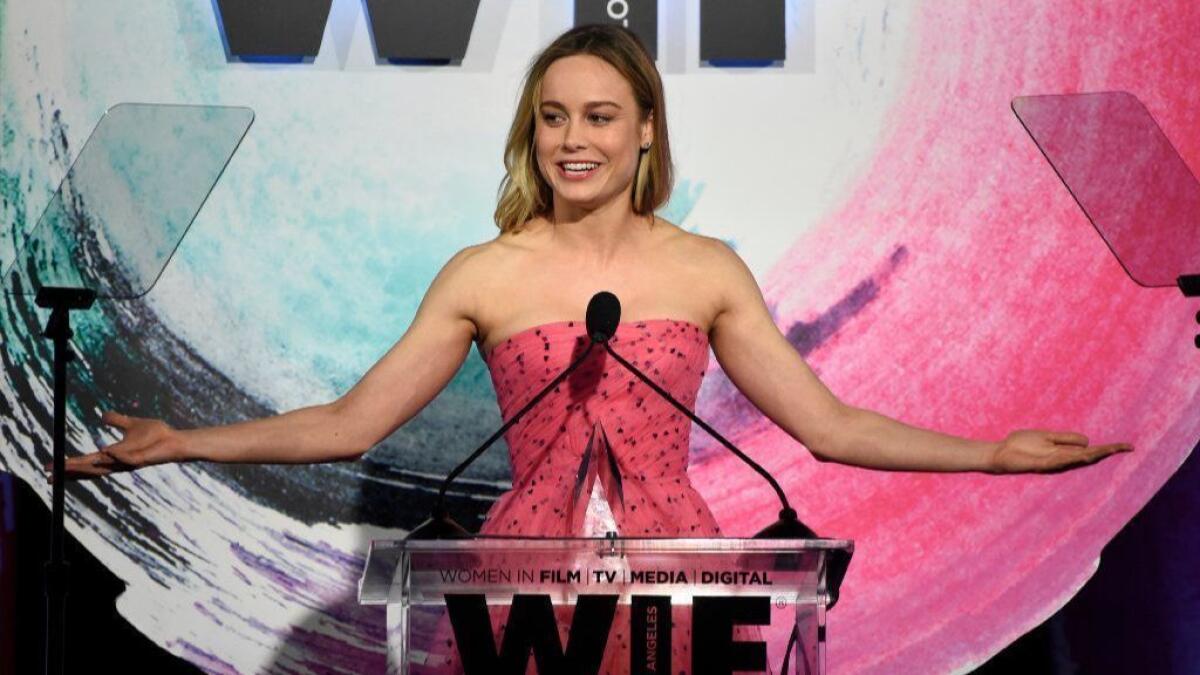Sundance and Toronto film festivals pledge increased access for underrepresented critics

- Share via
Brie Larson roused the entertainment industry Wednesday when she used her platform at Women in Film’s Crystal + Lucy Awards to drop sobering statistics from a recent USC study about the lack of diversity in film criticism. It’s a field so disproportionately skewed that white men wrote 63.9% of reviews aggregated by Rotten Tomatoes for the top 100 films of 2017, while women of color penned just 4.1%.
But the Oscar-winning actress and director’s call to action also offered a glimmer of hope: Larson revealed that the Sundance Film Festival will grant 20% of top level press badges for 2019 to underrepresented journalists, while the Toronto International Film Festival will increase its own accredited underrepresented media by 20%.
The pledges, from two of the most important and prestigious film festivals in the world, offered tangible examples of how long-needed industry change might finally come to fruition.
“We are planning to commit at least 20% of our top-tier press badges to underrepresented critics,” Sundance assistant director of media relations Spencer Alcorn confirmed Thursday.
Representatives of both Sundance and TIFF confirm that the umbrella of what constitutes “underrepresented” will include women, critics of color, disabled critics, as well as individuals who identify as LGBTQ.
The festival level is often where independent movies have make-or-break premieres, where social media buzz originates, and early reviews set a tone for not only how a film is discussed, but whether it lands a distribution deal — or not.
Even studio-backed Hollywood fare, particularly challenging, art house-leaning and Oscar-thirsty pictures, routinely debut at festivals like Sundance and TIFF where festival-accredited critics can help establish the cultural conversations integral to a film’s success.

“It really sucks that reviews matter, but reviews matter,” Larson said, speaking from experience; her indie drama “Room” was propelled to the Academy Awards by strong critical acclaim. “Good reviews out of festivals give small independent films a fighting chance to be bought and seen. Good reviews help films gross money. Good reviews slingshot films into awards contenders. A good review can change your life. It changed mine.”
Zeroing in on the importance of diverse voices in film criticism, Larson added: “I know that this means that my work will be shown, digested, discussed by a variety of people, not just a singular perspective. I want to know what my work means to the world, not a narrow view.”
The lens through which festival premieres are seen and analyzed is thus crucial to the life of a film, says TIFF vice president of public relations Andrea Grau. Industrywide conversations over fostering inclusivity behind the camera and on-screen should extend to who is covering those stories, she says.
“A conversation has been happening in terms of increasing the female filmmaker pipeline,” said Grau. “It’s the same conversation, but on the film critic side: Who is watching the film? Is it a woman? Is it a person of color? What is their background? And what other dialogue are they bringing to the conversation that is absent if they’re not there?”
Who is watching the film? ... And what other dialogue are they bringing to the conversation that is absent if they’re not there?
— Andrea Grau, vice president of public relations for TIFF
With an increasing emphasis on international representation, TIFF accredits 1,300 journalists, 30% of whom are from outside the U.S. and Canada. New application forms will include non-mandatory questions about how journalists self-identify, and the targeted 20% increase in underrepresented journalist accreditation matches realistic expectations of TIFF’s growth capacity, explained Grau.
TIFF also announced that funds from the Share Her Journey initiative launched last year will go toward granting female film critics resources to help attend the festival starting with this year’s edition in September.
The festival was already fostering greater diversity among its films, filmmakers, press and audience in particular, Grau says, in order to better reflect the diverse cultural makeup of the city.
“There are 96 languages spoken in Toronto the last time I checked, so it’s an extremely multicultural city and it’s important that the films that come here be diverse — not only in the filmmakers, but also the media that we have coming,” said Grau.
The decision to publicly announce the new commitments came together days prior to Larson’s Women in Film acceptance speech, initiated by her team. But both festivals already had their own independent inclusion initiatives in the works.
Sundance, held each January in Park City, Utah, currently accredits more than 1,000 journalists, assigning each media credential according to a three-tiered system of prioritized access. Critics largely fall into its “express pass” top tier, which is the badge level Sundance has promised to diversify starting this year.
Its 20% pledge “is one piece of a bigger plan that we’ve been working on since before the 2018 festival to overhaul the demographic makeup of the cultural critics at the festival,” said Karim Ahmad, director of inclusion and outreach at the Sundance Institute.
Ahmad joined the organization last year and heads a relatively new department devoted to fostering diversity across the institute, including Sundance’s artist programs and festival media corps.
He informally estimates that gender representation among Sundance press is “close to parity.” Anecdotally, however, “we are seeing race representation overwhelmingly imbalanced in favor of folks who are white,” he said.
The question is not merely which writers get access, but where their reviews are then published.
Underrepresented groups face uphill battles of inclusion and visibility in major media newsrooms — in roles such as staff journalists, critics and assigned freelance writers — which are also historically dominated by white men. That means Sundance and TIFF may give more consideration to freelance critics than in previous years.
It is our hope this year that we will be able to perhaps offer up, before assignment, a credential, and talk through where that work is going to be appearing.
— Spencer Alcorn, Sundance assistant director of media relations
“In the past we have accredited freelancers who are assigned,” said Alcorn. “It is our hope this year that we will be able to perhaps offer up, before assignment, a credential, and talk through where that work is going to be appearing.
“In the past while we’ve prioritized a lot of our accreditation based on size and reach, there’s so much more to that conversation now because there’s so much coverage out there that’s being used to determine [what happens to] these artists, and where their careers go.”
A greater consideration of critics’ demographics and area of interest means more individualized vetting — but also more opportunities in the near future for underrepresented critics not backed by major outlets to get a seat at the festival table, says Grau.
“We look at them one by one to really understand, which films does this journalist want to cover? What is their angle? What is the size of their outlet — but also what is the audience that they’re reaching, that we also need to reach as an organization?” she said. “It’s not just about numbers; it’s also about engagement. And that is a really important conversation that we need to have from an accreditation perspective.
“The festivals play a very important role in all of this, but we’re one part of a much larger ecosystem,” she added. “Editors need to be hiring underrepresented journalists. Marketing executives need to be hiring underrepresented individuals. It’s part of a larger effort, and I think collectively if we all do our part we can actually move the dial.”
More to Read
Only good movies
Get the Indie Focus newsletter, Mark Olsen's weekly guide to the world of cinema.
You may occasionally receive promotional content from the Los Angeles Times.











